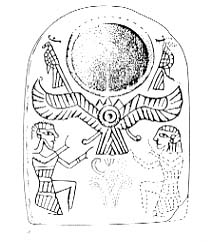Image Details

Dan Barag, Eretz Israel, 1985
“Tree of life.” A partially preserved palmette, highlighted in red, rests above a reconstructed proto-aeolic capital at center bottom of a seventh–sixth-century B.C.E. Phoenician stone cosmetic item (dashed lines indicate reconstructed areas). Cosmetic powder was mixed in the large round indentation at top. Two priests, rendered in Phoenician style, worship on either side of the tree of life. The two birds at top left and right are symbols of the goddess Astarte; at the center is an Egyptian style winged sun disc, symbol of the god Horus and long life. The “tree of life” depicted here in Phoenician style differs noticeably from the five-branched tree on the Dor scapula—a typical Assyrian form.
